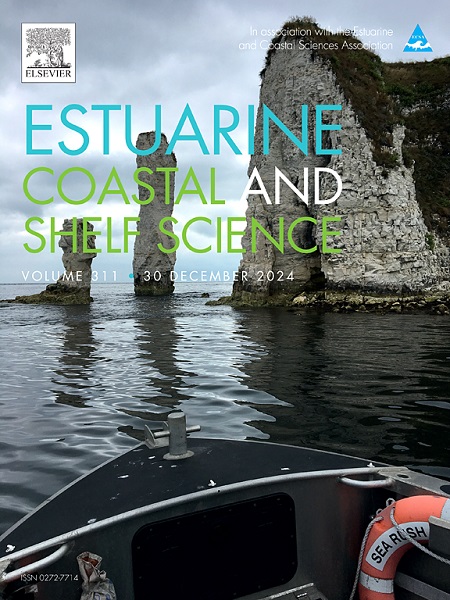Effect of ecosystem stressors on biogeochemical processes and bivalve-mediated bioremediation approaches for estuary resilience
IF 2.6
3区 地球科学
Q1 MARINE & FRESHWATER BIOLOGY
引用次数: 0
Abstract
Nutrient loading, derived from human-induced land-based activities, poses a significant risk of anthropogenic eutrophication in most estuaries worldwide and is considered a high-priority ecosystem stressor. Similarly, estuaries in the southern Gulf of Saint-Lawrence, Canada, are facing threats from this ecosystem stressor leading to potential nutrient over-enrichment, which not only affect primary production timing and abundance but can also alter the entire ecosystem dynamics. Determining the trophic condition of such estuaries becomes more critical when 58 % of the system is covered with natural populations of bivalve species. Therefore, we developed for the first time, a high-resolution 3-D coupled physical-biogeochemical model for the Bouctouche Estuary, Canada, based on Finite Volume Coastal Ocean Model and Integrated Compartment Model (FVCOM-ICM) whose water quality kinetics are further integrated with a benthic filter-feeder Dynamic Energy Budget (DEB) ecophysiological submodule to examine the present physical-biogeochemical condition, predict the responses of pelagic-benthic activity to different stages of nutrient loading and promote bivalve-mediated bioremediation approach. Results revealed that nutrient loading areas are characterized by low dissolved oxygen and biogeochemically distinct waters. Further, heterogeneity in estuarine biogeochemical processes is responding to water renewal time. Concomitantly, bivalves can bioextract about 11 % of riverine nitrogen inputs seasonally showing that both components can affect the net primary production distribution. Overall, this modeling framework will allow an ecosystem-based bioremediation approach for effective nutrient management to enhance estuary resilience.

生态系统压力源对生物地球化学过程的影响及双壳类生物修复方法
来自人类陆地活动的营养负荷对全球大多数河口的人为富营养化构成重大风险,被认为是高度优先的生态系统压力源。同样,加拿大圣劳伦斯湾南部的河口也面临着这一生态系统压力源的威胁,导致潜在的营养物质过度富集,这不仅影响初级生产的时间和丰度,还可能改变整个生态系统的动态。当58%的系统被双壳类物种的自然种群覆盖时,确定这些河口的营养状况变得更加重要。因此,基于有限体积海岸海洋模型和综合隔间模型(FVCOM-ICM),我们首次为加拿大Bouctouche河口开发了一个高分辨率的三维耦合物理-生物地球化学模型,该模型的水质动力学进一步与底栖滤料生物动态能量收支(DEB)生态生理子模块相结合,以研究当前的物理-生物地球化学条件。预测中上层底栖生物活动对不同阶段营养负荷的响应,促进双壳类生物修复方法。结果表明,营养负荷区以低溶解氧和生物地球化学特征明显的水体为特征。此外,河口生物地球化学过程的非均质性与水体更新时间有关。同时,双壳类动物可以季节性地生物提取约11%的河流氮输入,这表明这两种成分都可以影响净初级生产分布。总体而言,该建模框架将允许基于生态系统的生物修复方法进行有效的营养管理,以增强河口的恢复能力。
本文章由计算机程序翻译,如有差异,请以英文原文为准。
求助全文
约1分钟内获得全文
求助全文
来源期刊
CiteScore
5.60
自引率
7.10%
发文量
374
审稿时长
9 months
期刊介绍:
Estuarine, Coastal and Shelf Science is an international multidisciplinary journal devoted to the analysis of saline water phenomena ranging from the outer edge of the continental shelf to the upper limits of the tidal zone. The journal provides a unique forum, unifying the multidisciplinary approaches to the study of the oceanography of estuaries, coastal zones, and continental shelf seas. It features original research papers, review papers and short communications treating such disciplines as zoology, botany, geology, sedimentology, physical oceanography.

 求助内容:
求助内容: 应助结果提醒方式:
应助结果提醒方式:


